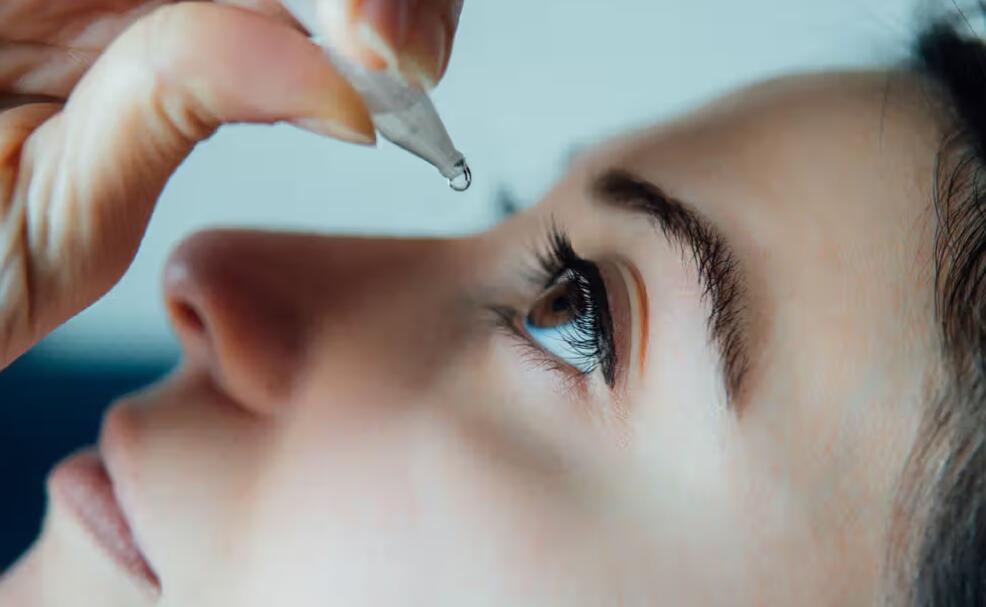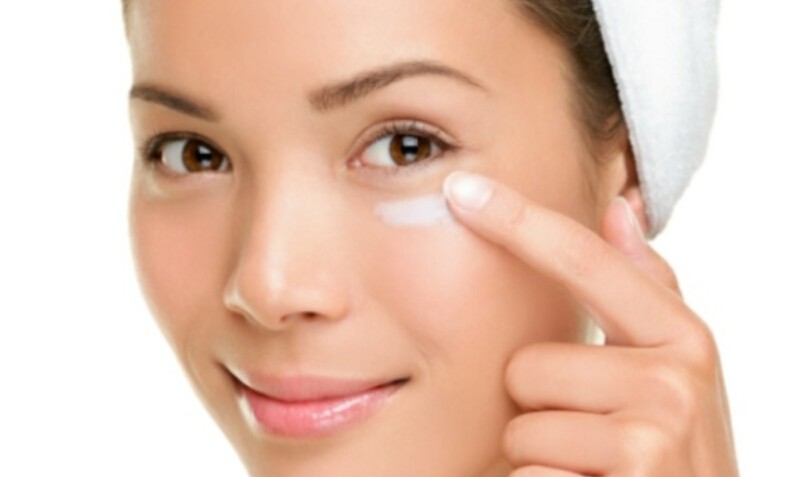Are you looking for a natural way to improve your eye health and alleviate common issues like dry eyes, eye bags, and even cataracts? Look no further than castor oil. This is a versatile vegetable oil derived from the seeds of the castor plant (Ricinus communis). It has been used for centuries to treat various eye conditions. In this article, we’ll discuss 16 potential benefits of castor oil for the eyes and provide instructions on how to use it safely.

16 Benefits of Castor Oil for Eyes
1. Moisturizes and Lubricates Dry Eyes
One of the most well-known benefits of castor oil for eyes is its ability to moisturize and lubricate the delicate skin around the eyes. This helps to alleviate the discomfort associated with dry eyes.
Castor oil is a common ingredient in many over-the-counter eye drops due to its lubricating properties. The ricinoleic acid in castor oil has been shown to reduce inflammation and improve the quality of tears. This makes it an effective natural treatment for dry eye syndrome.
2. Reduces Tear Evaporation
Castor oil helps stabilize the tear film on the surface of the eye, preventing tears from evaporating too quickly. This can lead to improved symptoms of dry eye and a more comfortable overall eye feel.
The oil’s unique composition allows it to form a protective layer over the tear film, locking in moisture and reducing evaporation. This is particularly beneficial for those who spend long hours in front of digital screens or live in dry, arid environments.
3. Improves Meibomian Gland Function
Meibomian glands, located along the eyelid margins, play a crucial role in producing the oily layer of the tear film. Castor oil can help improve meibomian gland function and reduce the symptoms of meibomian gland dysfunction, a common cause of dry eyes.
The oil’s anti-inflammatory properties help unclog blocked glands. This allows them to produce the necessary oils to maintain a healthy tear film.
4. Alleviates Blepharitis Symptoms
Blepharitis, or inflammation of the eyelids, can cause discomfort, redness, and irritation. A 2021 study suggested that applying castor oil twice daily for 4 weeks could help reduce blepharitis symptoms.
The oil’s antimicrobial properties help combat the bacteria that contribute to blepharitis. Plus, Castor oil can also help dissolve crusts that form along the eyelid margins, a common symptom of blepharitis.
5. Promotes Longer, Thicker Eyelashes
The antioxidants, proteins, vitamins, fatty acids, and nutrients in castor oil can nourish hair follicles and promote the growth of longer, thicker eyelashes. Regular application of castor oil to the lashes can help prevent breakage and encourage healthy growth.
The oil’s ricinoleic acid content stimulates blood circulation around the hair follicles, providing them with the necessary nutrients for optimal growth. Many users report seeing significant improvements in the length and thickness of their lashes after just a few weeks of consistent use.
6. Strengthens and Moisturizes Eyebrows
Just as castor oil can benefit eyelashes, it can also work wonders for eyebrows. The rich nutrients in castor oil help to strengthen and moisturize eyebrow hair, promoting a fuller, healthier appearance.
The oil’s fatty acids nourish the hair follicles, preventing breakage and encouraging growth. In addition, Castor oil can also help tame unruly eyebrows, making them easier to shape and style.
7. Reduces Under-Eye Puffiness and Dark Circles
The anti-inflammatory properties of castor oil can help reduce puffiness and dark circles under the eyes. Gently massaging a small amount of castor oil around the eye area can promote better circulation and diminish the appearance of eye bags.
The oil’s antioxidants help combat free radicals that contribute to the breakdown of collagen and elastin, the proteins responsible for keeping skin firm and youthful. Regular use of castor oil can help fade dark circles and give your under-eye area a brighter, more refreshed appearance.

8. Fights Wrinkles and Fine Lines
Castor oil’s moisturizing properties can help plump up the delicate skin around the eyes, reducing the appearance of wrinkles and fine lines. The oil’s fatty acids nourish and hydrate the skin, promoting a more youthful look.
Castor oil is also rich in antioxidants, which help protect the skin from damage caused by free radicals and environmental stressors. In addition, castor oil can help slow down the aging process and maintain a smoother, more supple appearance.
9. Soothes Irritated Eyes
The anti-inflammatory and antimicrobial properties of castor oil can help soothe irritated eyes. This provides relief from redness, itching, and discomfort. Whether your eyes are irritated due to allergies, environmental factors, or other causes, castor oil can help calm and heal the delicate skin around your eyes.
You can simply apply a small amount of the oil to your eyelids and gently massage it in. Be careful not to get any oil directly in your eyes.
10. May Help with Cataracts
While more research is needed, some studies suggest that the antioxidants in castor oil may help slow the progression of cataracts, a common age-related eye condition that causes cloudy vision. Cataracts form when proteins in the eye’s lens begin to clump together, causing the lens to become cloudy and obscuring vision.
The antioxidants in castor oil, such as vitamin E, may help protect the lens from oxidative damage and slow down the formation of cataracts. However, it’s important to note that castor oil should not be used as a substitute for proper medical treatment of cataracts.
11. Potential Benefits for Eye Floaters
Eye floaters are small specks or lines that appear in your vision, often more noticeable against a bright background. Some anecdotal evidence suggests that castor oil may help reduce the appearance of eye floaters.
The theory behind this potential benefit is that the oil’s anti-inflammatory properties may help reduce inflammation in the vitreous humor. This can contribute to the formation of floaters. However, it’s crucial to consult with an eye doctor if you experience a sudden increase in eye floaters, as this may be a sign of a more serious underlying condition.
12. Nourishes and Protects the Skin Around the Eyes
The skin around the eyes is thin and delicate, making it more susceptible to dryness, irritation, and signs of aging. Castor oil’s rich nutrients and moisturizing properties help nourish and protect this sensitive area.
The oil’s fatty acids help strengthen the skin’s natural barrier, locking in moisture and keeping harmful environmental factors out. Regular use of castor oil can help keep the skin around your eyes soft, smooth, and supple.
13. Enhances Overall Eye Health
The various nutrients found in castor oil, including vitamin E, minerals, and fatty acids, work together to support overall eye health.
The oil’s antioxidants help protect your eyes from damage caused by free radicals, while its anti-inflammatory properties can help reduce the risk of various eye conditions. Regular use of castor oil can help keep your eyes feeling comfortable, refreshed, and healthy.
14. Affordable and Accessible
Compared to many commercial eye care products, castor oil is an affordable and easily accessible option. You can find castor oil at most health food stores, pharmacies, and online retailers. This makes it a convenient choice for those looking to improve their eye health naturally. A small bottle of castor oil can last for months, providing you with a cost-effective way to care for your eyes.
15. Versatile and Easy to Use
Castor oil is incredibly versatile and easy to incorporate into your eye care routine. You can apply it directly to the skin around your eyes, use it as an ingredient in homemade eye drops, or even add a few drops to your favorite eye cream or serum. Here are a few simple ways to use castor oil for your eyes:
- Eyelid Massage: Apply a small amount of castor oil to your fingertips and gently massage it into your eyelids and the skin around your eyes, using circular motions. This can help improve circulation, reduce puffiness, and moisturize the skin.
- Eyelash and Eyebrow Treatment: Use a clean mascara wand or a small brush to apply castor oil to your eyelashes and eyebrows. This can help nourish the hair follicles and promote healthier, thicker lashes and brows.
- Homemade Eye Drops: Mix a small amount of castor oil with a sterile saline solution to create homemade eye drops. Use a clean, sterile dropper to apply the drops to your eyes. Be careful not to touch the dropper to your eye or any other surface.
16. Suitable for Most Skin Types
Castor oil is generally well-tolerated and suitable for most skin types, including sensitive skin. However, as with any new product, it’s essential to do a patch test before applying castor oil to your eyes to ensure you don’t have an allergic reaction.
To perform a patch test, apply a small amount of castor oil to a small area of skin on your inner arm and wait 24 hours to see if any redness, itching, or irritation occurs. If you don’t experience any adverse reactions, you can safely use castor oil on your eyes and the surrounding skin.

How to Use Castor Oil for Eyes Safely?
When using castor oil for your eyes, it’s crucial to follow proper safety guidelines to avoid irritation or infection:
- Always use a high-quality, pure, organic castor oil that is free from additives or preservatives.
- Perform a patch test on a small area of skin before applying castor oil to your eyes to check for any adverse reactions.
- Ensure your hands and face are clean before applying castor oil to your eyes or eyelids.
- Use a clean, sterile dropper or applicator to apply the oil to your eyes or eyelids.
- If using castor oil eye drops, follow the instructions carefully and do not exceed the recommended dosage.
- Discontinue use if you experience any irritation, redness, or discomfort, and consult with your eye doctor if symptoms persist.
Precautions and Considerations
While castor oil is generally safe for most people to use around their eyes, there are a few precautions to keep in mind:
- Allergic Reactions: Some people may be allergic to castor oil. If you experience any itching, redness, or swelling after using castor oil on your eyes, discontinue use immediately and consult with your eye doctor.
- Eye Irritation: If castor oil gets directly into your eyes, it may cause temporary irritation or blurred vision. If this occurs, rinse your eyes thoroughly with cool water and avoid rubbing them.
- Interactions with Medications: If you are taking any medications, particularly eye medications, consult with your doctor before using castor oil on your eyes to ensure there are no potential interactions.
- Pregnancy and Breastfeeding: While castor oil is generally considered safe for topical use during pregnancy and breastfeeding, it’s always best to consult with your healthcare provider before using any new products during these times.
Common Questions and Answers
1. Is it safe to use castor oil on my eyes?
Yes, castor oil is generally safe to use on the skin around your eyes and on your eyelashes and eyebrows. However, it’s essential to use a high-quality, pure, organic castor oil and to perform a patch test before applying it to your eyes to ensure you don’t have an allergic reaction. If you experience any irritation, redness, or discomfort, discontinue use and consult with your eye doctor.
2. How often should I apply castor oil to my eyes?
The frequency of application depends on your specific needs and goals. For general eye health and moisturization, you can apply castor oil to your eyelids and the skin around your eyes once or twice daily. If you’re using castor oil to promote eyelash or eyebrow growth, you can apply it to your lashes and brows once a day, preferably at night before bed.
3. How long does it take to see results from using castor oil on eyelashes and eyebrows?
The time it takes to see results varies from person to person. Some people may notice improvements in the appearance of their eyelashes and eyebrows within a few weeks of consistent use, while others may take longer to see visible changes. Typically, you can expect to see fuller, thicker lashes and brows within 2-3 months of regular castor oil application.
4. Can I use castor oil if I wear contact lenses?
If you wear contact lenses, it’s best to remove them before applying castor oil to your eyes or eyelids. Wait at least 15-20 minutes after applying the oil before reinserting your contact lenses to avoid any potential irritation or discomfort. If you experience any issues with your contact lenses after using castor oil, consult with your eye doctor.
5. How do I store castor oil, and how long does it last?
Store your castor oil in a cool, dry place away from direct sunlight. Properly stored castor oil can last for up to 1 year. Always check the expiration date on your castor oil and discard it if it has expired or if you notice any changes in its color, texture, or smell.
6. Can I use castor oil if I have sensitive skin?
Castor oil is generally well-tolerated and suitable for most skin types, including sensitive skin. However, it’s crucial to perform a patch test before applying castor oil to your eyes to ensure you don’t have an allergic reaction. If you have particularly sensitive skin or a history of allergies, it’s best to consult with your eye doctor or dermatologist before using castor oil on your eyes.






